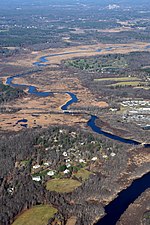The Minute Man

The Minute Man is an 1874 sculpture by Daniel Chester French in Minute Man National Historical Park, Concord, Massachusetts. It was created between 1871 and 1874 after extensive research, and was originally intended to be made of stone. The medium was switched to bronze and it was cast from ten Civil War-era cannons appropriated by Congress. The statue depicts a minuteman stepping away from his plow to join the patriot forces at the Battle of Concord, at the start of the American Revolutionary War. The young man has an overcoat thrown over his plow, and has a musket in his hand. Nineteenth-century art historians noticed that the pose resembles the pose of the Apollo Belvedere. Until the late twentieth century, it was assumed that the pose was transposed from the earlier statue. Based on Daniel Chester French's journals, modern art historians have shown that the Apollo Belvedere was only one of several statues that were used in the research for The Minute Man. The statue was unveiled in 1875 for the centennial of the Battle of Concord. It received critical acclaim and continues to be praised by commentators. The statue has been a suffragette symbol and a symbol of the United States National Guard and its components, the Army National Guard, and the Air National Guard, and depicted on coins such as the 1925 Lexington–Concord Sesquicentennial half dollar and the 2000 Massachusetts state quarter.
Excerpt from the Wikipedia article The Minute Man (License: CC BY-SA 3.0, Authors, Images).The Minute Man
Old North Bridge,
Geographical coordinates (GPS) Address Nearby Places Show on map
Geographical coordinates (GPS)
| Latitude | Longitude |
|---|---|
| N 42.468916666667 ° | E -71.351277777778 ° |
Address
Old North Bridge site
Old North Bridge
01742
Massachusetts, United States
Open on Google Maps











